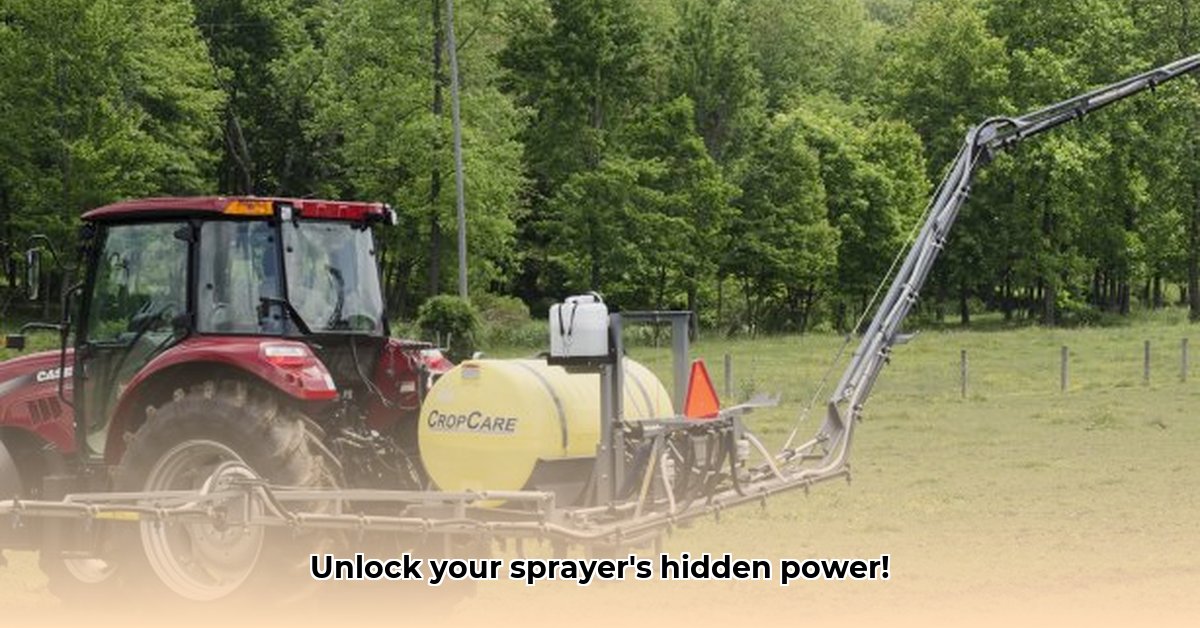
This comprehensive guide provides farmers of all sizes with the knowledge and tools to effectively utilize 3-point hitch sprayers for efficient and sustainable agricultural practices. We'll cover everything from selecting the ideal sprayer for your operation to implementing environmentally conscious spraying techniques and maximizing your return on investment. For more sprayer options, check out this helpful resource: tractor sprayers.
Choosing the Right Sprayer: A Tailored Approach
Selecting the right 3-point hitch sprayer hinges on several crucial factors: farm size, crop type, budget, and desired application method. A small-scale operation might benefit from a smaller, electric-powered sprayer with a 25-50 gallon tank capacity, while larger farms might require a PTO (power take-off)-driven model with a capacity of 150-300+ gallons for optimal efficiency.
The choice between PTO and electric sprayers significantly impacts both operational costs and environmental impact. PTO sprayers offer reliable power, especially for high-pressure applications and harsher chemicals, while electric options provide quieter operation and potentially lower fuel consumption, aligning with sustainable practices.
Application methods also influence sprayer selection. Boom sprayers are highly effective for covering large areas quickly, while wand sprayers provide more precise application for spot treatments or smaller areas. Consider the following table for a clearer picture:
| Feature | Small Garden/Hobby Farm | Small to Medium Farm | Large-Scale Operation |
|---|---|---|---|
| Tank Capacity (gallons) | 25-50 | 50-150 | 150-300+ |
| Pump Type | Electric (battery or 12V) | PTO or Electric | PTO (for consistent power) |
| Application Method | Wand or small boom spray | Boom spray, possibly wand | Boom spray, potentially GPS-guided |
| Budget | Lower | Moderate | Higher |
Remember, this is a guideline—thoroughly assess your specific needs before making a purchase. Don't forget to confirm your tractor's lifting capacity to ensure compatibility with your chosen sprayer.
Operational Considerations: Maximizing Performance and Safety
Proper sprayer operation is key for both efficiency and safety. Always begin by carefully reviewing the manufacturer's instructions. Regular maintenance is crucial: after each use, thoroughly clean the sprayer to prevent clogging and corrosion. This extends the lifespan of the equipment and prevents costly repairs. "Proper cleaning is not just about neatness; it's about ensuring accurate application and avoiding costly repairs," notes Dr. Emily Carter, Agricultural Engineer at Purdue University.
Calibration is paramount for precise chemical application. Inaccurate calibration leads to wasted chemicals and potential negative environmental impacts. Follow these steps for accurate calibration:
- Pre-Spray Inspection: Check all hoses, connections, and nozzles for damage or leaks.
- Tank Filling: Carefully fill the tank, using appropriate personal protective equipment (PPE).
- Nozzle Adjustment: Adjust nozzles to the manufacturer's recommendations or according to your calibration.
- Consistent Speed: Maintain a consistent speed during spraying for even coverage.
- Post-Spray Cleaning: Thoroughly clean the sprayer and dispose of leftover chemicals responsibly according to local regulations.
Sustainable Practices with 3-Point Sprayers: Minimizing Environmental Impact
Sustainable agricultural practices are increasingly critical. 3-point hitch sprayers, when used correctly, can contribute significantly. Precision application techniques, such as variable rate technology (often integrated with GPS), allow for targeted chemical application, minimizing waste and environmental impact. "Variable rate technology can reduce chemical usage by up to 40%, leading to significant cost savings and environmental benefits," explains Dr. John Smith, Professor of Agronomy at the University of Minnesota.
Explore the use of organic and biopesticides whenever feasible. These environmentally friendly alternatives promote healthy soil and reduce reliance on synthetic chemicals. Responsible chemical disposal is also vital – always adhere to local regulations for safe and legal disposal.
Cost-Effectiveness and ROI: A Long-Term Perspective
The initial investment in a 3-point hitch sprayer can be significant. However, the long-term benefits, including reduced labor costs, increased efficiency, and healthier crops, often result in a strong return on investment (ROI). To accurately assess your ROI, consider all factors: initial purchase price, fuel consumption, maintenance, and chemical costs. Proper maintenance significantly extends equipment lifespan, minimizing repair costs. For smaller farms, shared equipment models or leasing options can help mitigate the upfront investment.
Future Trends and Innovations: The Evolving Landscape
Sprayer technology is continually advancing. Expect to see more sustainable materials used in construction, along with innovations in nozzle design for improved accuracy and reduced spray drift. Furthermore, the integration of smart farming technologies, like automated guidance systems, promises even greater precision, resulting in further reduced chemical use and a more environmentally sound approach to agriculture. Staying informed about these advancements will allow you to adapt and optimize your operations for increased efficiency and sustainability.